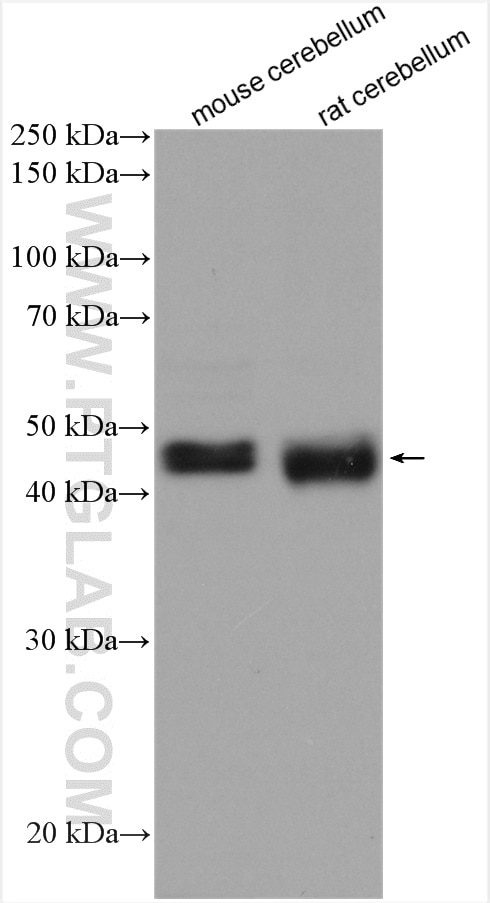NEGR1 Polyklonaler Antikörper
NEGR1 Polyklonal Antikörper für WB, ELISA
Wirt / Isotyp
Kaninchen / IgG
Getestete Reaktivität
human, Maus, Ratte
Anwendung
WB, IF, ELISA
Konjugation
Unkonjugiert
Kat-Nr. : 13674-1-AP
Synonyme
Geprüfte Anwendungen
| Erfolgreiche Detektion in WB | Maus-Cerebellum-Gewebe, Ratten-Cerebellum-Gewebe |
Empfohlene Verdünnung
| Anwendung | Verdünnung |
|---|---|
| Western Blot (WB) | WB : 1:500-1:3000 |
| It is recommended that this reagent should be titrated in each testing system to obtain optimal results. | |
| Sample-dependent, check data in validation data gallery | |
Veröffentlichte Anwendungen
| IF | See 1 publications below |
Produktinformation
13674-1-AP bindet in WB, IF, ELISA NEGR1 und zeigt Reaktivität mit human, Maus, Ratten
| Getestete Reaktivität | human, Maus, Ratte |
| In Publikationen genannte Reaktivität | Maus |
| Wirt / Isotyp | Kaninchen / IgG |
| Klonalität | Polyklonal |
| Typ | Antikörper |
| Immunogen | NEGR1 fusion protein Ag4659 |
| Vollständiger Name | neuronal growth regulator 1 |
| Berechnetes Molekulargewicht | 226 aa, 25 kDa |
| Beobachtetes Molekulargewicht | 46 kDa |
| GenBank-Zugangsnummer | BC036771 |
| Gene symbol | NEGR1 |
| Gene ID (NCBI) | 257194 |
| Konjugation | Unkonjugiert |
| Form | Liquid |
| Reinigungsmethode | Antigen-Affinitätsreinigung |
| Lagerungspuffer | PBS with 0.02% sodium azide and 50% glycerol |
| Lagerungsbedingungen | Bei -20°C lagern. Nach dem Versand ein Jahr lang stabil Aliquotieren ist bei -20oC Lagerung nicht notwendig. 20ul Größen enthalten 0,1% BSA. |
Protokolle
| PRODUKTSPEZIFISCHE PROTOKOLLE | |
|---|---|
| WB protocol for NEGR1 antibody 13674-1-AP | Protokoll herunterladen |
| STANDARD-PROTOKOLLE | |
|---|---|
| Klicken Sie hier, um unsere Standardprotokolle anzuzeigen |
Publikationen
| Species | Application | Title |
|---|---|---|
iScience Using brain cell-type-specific protein interactomes to interpret neurodevelopmental genetic signals in schizophrenia | ||
Cell Rep Exercise training remodels inguinal white adipose tissue through adaptations in innervation, vascularization, and the extracellular matrix |


